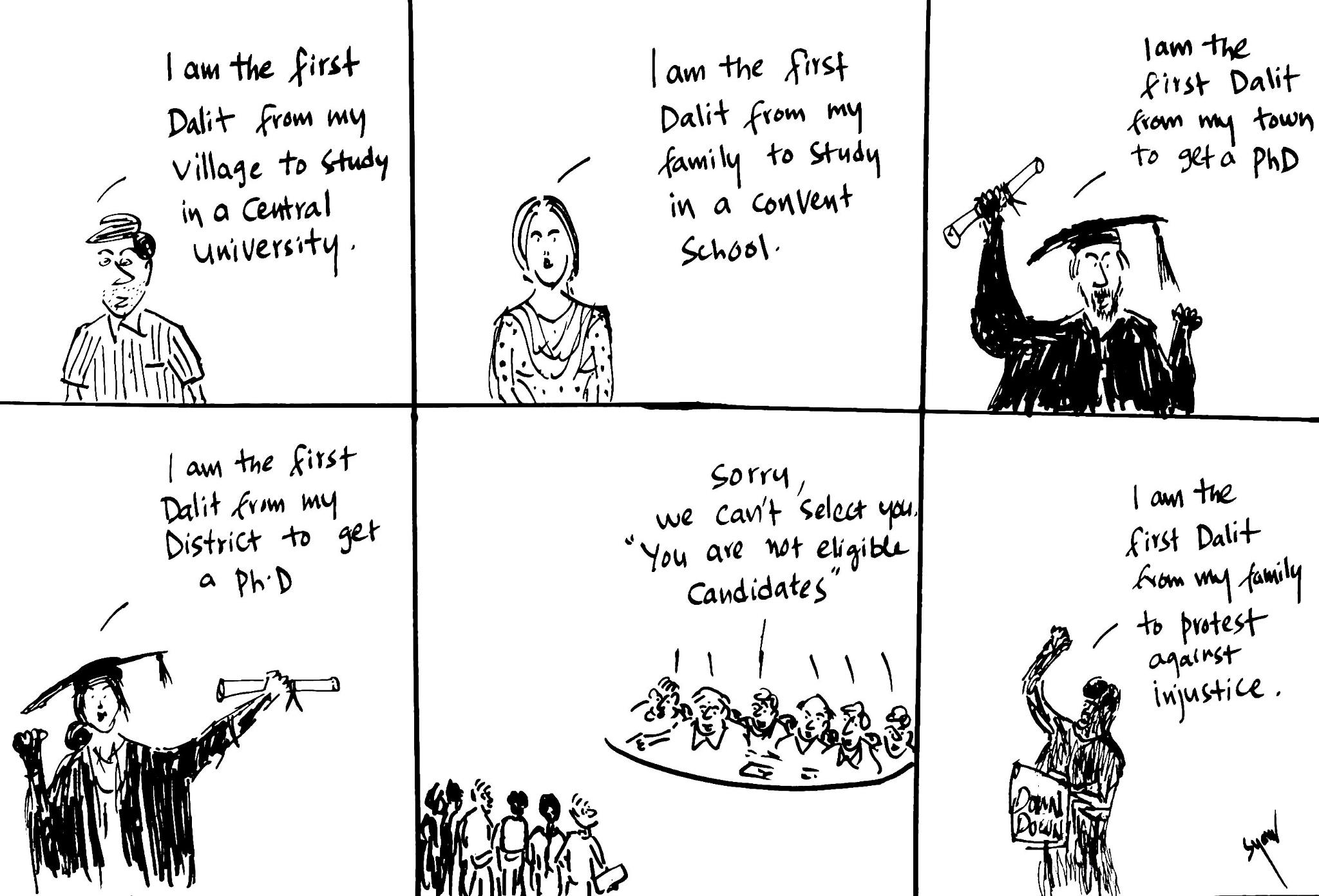Anuraag Khaund
 Often while engaging in a debate with my friends from other parts of India especially the North in my campus in Guwahati over the present contemporary contentious issue of dietary preferences, I am mostly met with the following rhetoric- Don’t you have compassion in your heart? Don’t you feel a pain in your heart every time you bite a tandoori? And it continues. On the broader picture meat, especially beef has today emerged as a marker of nationalism and citizenship with “violators” either lynched as in the case of Dadri or stabbed to death like Hafiz Junaid. However, the common feature of these two aforementioned incidents and my debates in college is the increasing emphasis on the notion of certain dietary practices as being “impure” which ought to be abolished, even with violence if necessary and the imposition of a “purer” form of food habit. Vegetarianism, widely celebrated and ascribed a status of respect within ‘Hinduism’ was also seen as a marker of difference between the stratifications of the caste system with sections having a strong preference for meat being relegated to the lowest rungs of the caste structure as non-veg dietary practices were perceived as impure. However, if examined closely, Vedic Hinduism has an association with meat and especially beef, stretching back in time.
Often while engaging in a debate with my friends from other parts of India especially the North in my campus in Guwahati over the present contemporary contentious issue of dietary preferences, I am mostly met with the following rhetoric- Don’t you have compassion in your heart? Don’t you feel a pain in your heart every time you bite a tandoori? And it continues. On the broader picture meat, especially beef has today emerged as a marker of nationalism and citizenship with “violators” either lynched as in the case of Dadri or stabbed to death like Hafiz Junaid. However, the common feature of these two aforementioned incidents and my debates in college is the increasing emphasis on the notion of certain dietary practices as being “impure” which ought to be abolished, even with violence if necessary and the imposition of a “purer” form of food habit. Vegetarianism, widely celebrated and ascribed a status of respect within ‘Hinduism’ was also seen as a marker of difference between the stratifications of the caste system with sections having a strong preference for meat being relegated to the lowest rungs of the caste structure as non-veg dietary practices were perceived as impure. However, if examined closely, Vedic Hinduism has an association with meat and especially beef, stretching back in time.
To start with the non-vegetarian legacy of Hinduism, the evidence can be gleaned from the Vedas- considered the highest authority on the religious practices and social life itself. The Vedas list around 250 animals, out of which 50 are deemed as suitable for sacrifice and by inference, for consumption. The accounts of the period mention of the presence of sellers of different types of meat- cattle (gogataka), sheep (arabika), pig (shookarika), deer (nagarika) and even tortoise ( giddabuddaka). Consumption of meat can be traced back even from the period of the Indus Valley civilization with the prevalence of charred remains of animals such as humped cattle, gharial, fish, deer etc. The epics of Ramayana and Mahabharata are also replete with instances of non-vegetarian dietary practices, during their exile in the forest Rama, Sita and Laxmana are said to have relished a dish made of meat with rice and vegetables. The Mahabharata has references to rice cooked with minced meat (pistaudana) and picnics where various kinds of roasted game and game birds were served. Buffalo meat was fried in ghee with rock salt, fruit juices, powdered black pepper, asafetida (hingu) and caraway seeds, and served garnished with radishes, pomegranate seeds and lemons.
On the question of beef consumption, the Vedas can be cited again especially the Rigveda which calls for the cooking of a fit ox for Indra, the strongest among the Vedic deities and the destroyer of enemy strongholds. It is also mentioned that Indra is said to have ‘eaten the flesh of bulls, of one or hundred buffaloes or 300 buffaloes roasted by Agni or a thousand buffaloes’. The latter Agni, the Vedic god of fire, is described in the Rigveda as ‘one whose food is the ox and the barren cow’. The later Vedic texts include detailed descriptions of sacrifices and even ritualized slaughter of cattle where a bull was sacrificed to Indra, a dappled cow to the Maruts and the copper-colored cow to the Asvins. Cow sacrifice (Gosava) was an integral part of auspicious ceremonies such as rajasuya and the ashwamedha (horse sacrifice) where the ceremony was concluded by the sacrifice of 21 sterile cows.The killing of kine was also part of everyday activities as can be inferred from the Aitareya Brahmana which states that ‘if the ruler of men comes as a guest or anyone else deserving of honor comes, people kill a bull or a cow and beef formed a part of daily diet of even sages and Brahmanas as stated by Yajnavalka, the sage of Mithila, who preferred beef over other animals.
Meat consumption was also associated with certain deities such as Shiva who began as a minor Vedic god known as Rudra and said is to be a forest dweller and an ace archer who hunted and ate his own prey. Much later with the inclusion of Shiva in the Puranic pantheon his role as the destroyer is highlighted along with his wrathful nature and fondness for meat both animals and humans alike. The Mahabharata also mentions of Jarasandha, the king of Magadha of keeping human captives to be sacrificed to Lord Shiva. Cults which developed around the deity, such as Kaula Kapalikas and Aghoripanthis not only indulged in drinking wine and consuming animal and human corpses but also engaged in sexual intercourse with dead bodies.
However, with the beginning of the urbanization of the Gangetic plains around the middle of the first millennium BCE simultaneously with the development of agriculture and especially with an increase in the practice of granting land endowments upon Brahmins led to the association of sacredness with the cow as it formed an integral and vital part of the agricultural system. Along with such developments, consumption of beef and other meats came to be seen as a marker of difference between the various castes with non-vegetarian “polluting” dietary practices being relegated to the lower castes. Over a period of time vegetarianism emerged as a divine ideal to be emulated by all the twice-born castes while non-vegetarianism began to be viewed as demeaning and impure and imparting of meat was equated with losing one’s caste purity which required penance and other rituals.
Coming to present times, with the rise of saffronist sentiments and the Hindutva rhetoric there has been a drive by the ruling regime to enforce an ideal of vegetarianism which is based less on genuine compassion for animals and more on the caste division based on dietary practices. Echoes of such sentiments can be found in the legislation such as the ban on beef, restrictions on the sale of meat and eggs in Dadri during the Kanwar Yatra undertaken by devotees of Shiva (ironically who is associated with consumption of meat), spiritual guru Ramaraju Mahanthi’s labelling of non-vegetarians as demons etc. Why is a practice of the upper castes being enforced forcefully? The faster India’s non-vegetarian legacy and diversity of cults and practices which are often in opposition to the brahminical hegemony is acknowledged the better will be our efforts in alleviating the present saffron crisis besetting India.
References
1. Jha Narayan Dwijendra. The Myth of the Holy Cow (Navayana Publishing, 2009; Matrix Books, New Delhi, 2001)
2. Pande Mrinal. Scroll.in, April 10, 2017. From Ramayana to the scriptures, it’s clear India has a long history of eating meat.
3. Sharma Ruchika. Scroll.in, July 29, 2017, How Shiva was transformed from a meat loving deity to a vegetarian god.
4. Waghmore Suryakant. Scroll.in, April 06, 2017, In charts: Vegetarianism in India has more to do with caste hierarchy than love for animals.
~~~
Anurag Khaund final year in Bachelor of Arts in Social Sciences (BASS) in Tata Institute of Social Sciences (TISS) Guwahati.










